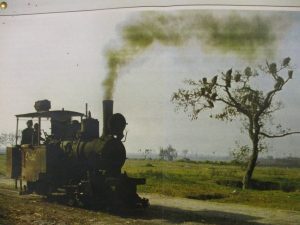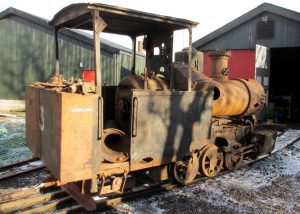‘CHEETAL’.
John Fowler & Company (Leeds) Limited, Works Number 15991, 0-6-0 Well Tank Locomotive.
Formerly used at Karachi Port Trust and at Khatauli Sugar Mill, Uttar Pradesh, India.
John Fowler came from a Quaker family of corn merchants but decided to leave the family business and pursue a career as an engineer. He visited Ireland in the wake of the great potato famine and this experience set him on a path of looking for engineering solutions to increase food production. He established the Steam Plough Works in Leeds in 1860 to produce his famous ploughing engines and added the production of main line railway locomotives in 1866. Early locomotives included one’s for the London Chatham and Dover Railway, the Great Northern Railway and the Imperial Mexican Railways. In 1878 the French engineer Paul Decauville licensed Fowler to produce his portable railway system. This led to a focus on narrow gauge locomotives, and in particular for agricultural uses such as sugar plantations with the vast majority of Fowler locomotives built for export. The firm experimented with internal combustion engines from the early 1900s and delivered their first internal combustion locomotive in 1922, leading to the development of a range of narrow and standard gauge diesel locomotives. The last steam locomotive was built in by Fowler in 1936, but two further locomotives were built for the firm, one by Kitson in 1936 and the other by Hudswell Clarke in 1938. Finally, in 1954 locomotive designs were licensed to the Bundaberg Foundry Company in Queensland, Australia who built eight locomotives for the Australian sugar industry.

John Fowler Works Photograph of Cheetal.
Photograph courtesy of the Museum of English Rural Life.

Cheetal at Khatauli Sugar Mill.
Photograph by the late Lawrence Marshall.
Cheetal was works number 15991 of 1923, one of two, 0-6-0 inside framed well tank locos for the Karachi Port Trust (then India, now Pakistan). Karachi was developed as a port from the mid-19th Century and the two locomotives are thought to have been ordered in connection with works in the 1920s to expand the port facilities and for hauling supplies to port installations. Both locomotives were sold to different sugar mills in the 1930s, with 15991 passing to the Upper India Sugar Mills at Khatauli. This is a large sugar mill opened in 1933 in what was then the United Provinces (now Uttar Pradesh) about 50 miles north east of Dehli. There, it acquired the name Cheetal (a deer species native to the Indian subcontinent).
The design was a departure for Fowler from their traditional narrow gauge side tank and saddle tank designs and followed a trend by British manufacturers to adopt the cheaper to produce German design of inside framed well tank industrial narrow gauge locomotives. This move followed the loss of any patent protection during the First World War. Subsequently, Fowler built at least four more locomotives of this type, but slightly smaller, for customers in India.
At Khatauli, 15991 was fitted with a steam turbo-generator and large electric headlights for night-time operation during sugar cane harvesting. The locomotive was also fitted with an additional water tank behind the cab to allow for the longer runs on the sugar cane line. Cheetal worked at Khatauli until the narrow gauge railway system there was abandoned in favour of road transport in 1984. It is believed that the well-known photographer and enthusiast of Indian railways, Lawrence Marshall, was instrumental in saving the locomotive along with two World War 1 Baldwin 4-6-0 locomotives at Khatauli and securing their move to the UK. Amberley Museum bought one of the Baldwin locomotives and facilitated the purchase of Cheetal by Leeds City Museums who were then building up a collection of Leeds-built locomotives. The locomotive arrived in Leeds in March 1985, travelling from India with the two Baldwin locomotives via the port of Felixstowe.
In 2013 the West Lancashire Locomotive Trust reached an agreement with Leeds Industrial Museum for the long-term loan of the locomotive. The locomotive is currently stored at the West Lancashire Light Railway and the Trust is developing a conservation and restoration plan to restore Cheetal to running order so that the locomotive can be seen in operation at a variety of heritage railways, including a return to Leeds Industrial Museum at Armley Mills. The locomotive requires extensive boiler work and much other work, including a permanent repair to one of its wheels, following a makeshift repair undertaken in its last years in India.
Cheetal is an interesting locomotive, representing: the importance of the export market for British locomotive builders, Britain’s colonial past and evolution in narrow gauge steam locomotive design and manufacturing. It also has many stories to tell from its hard, working life in India.

Cheetal in store at Leeds Industrial Museum, Armley Mills.



